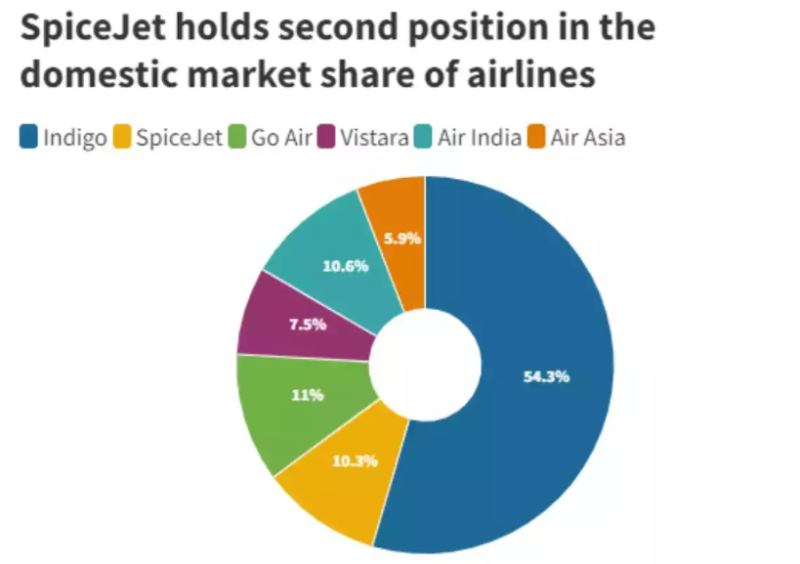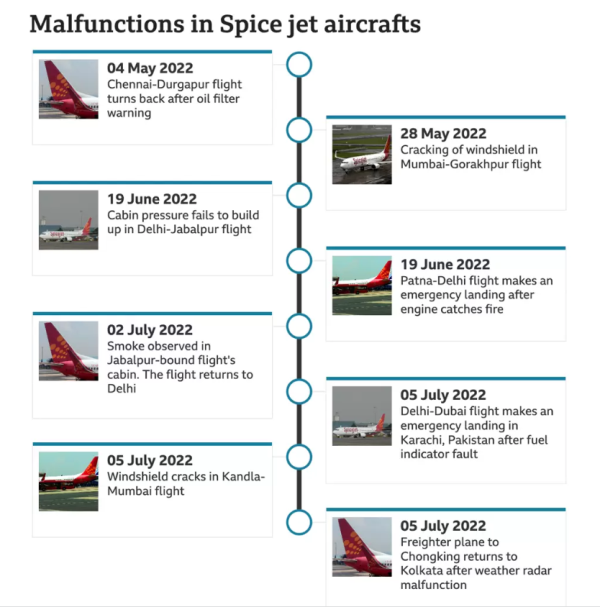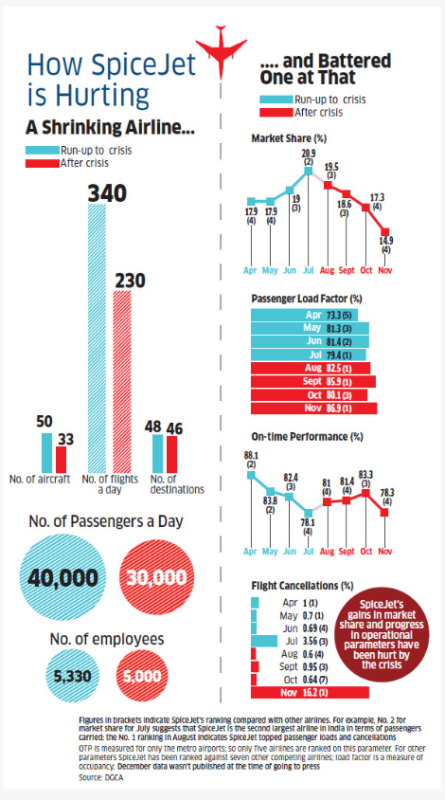Is SpiceJet in the Eye of a Storm?: A Case Study
SpiceJet is one of the lowest-cost airlines. It was established as an Airtaxi provider by Modiluft in 1994 and then acquired by Ajay Singh, who re-created it as SpiceJet in 2004. Its current headquarters is in Gurugram, India.
The airline flies 630 flights daily to 64 destinations, which include 54 Indian and 15 international destinations. It is one of the largest cargo in terms of domestic as well as global cargo operations. The market share of SpiceJet is 13.6% as per the data of March 2019. Today, SpiceJet has come to be known as one of the failed airlines in India.
What is the problem with SpiceJet?
The Indian aviation industry has been facing tremendous turbulence in the recent past. From the bankruptcy of Kingfisher to the losses of Jet Airways and the Mid-air technical faults of SpiceJet in news, the aviation industry in India is going through a tough time. Not long ago, SpiceJet exuded a culture of exuberance and flamboyance synonymous with successful low-cost airlines around the globe. However, the recent incidents in the past few years have raised a question mark on the brand’s very existence in the market.
Can SpiceJet survive?
The SpiceJet case describes the plight of the country’s popular low-cost airline, which found itself in a severe liquidity crisis that led it to almost shut down in December 2014. By then, SpiceJet neither had money to fuel its planes nor to run its operations or pay salaries to employees, airport duties, and taxes. Fuel companies had refused to extend further credit to the debt-ridden airline until it settled its past dues. By late 2014, the operational footprint of the air carrier had reduced to 32 from 58 planes.
In January 2015, Ajay Singh, ex-chairman and founder of SpiceJet, came back on board five years after selling the airline to media baron Kalanithi Maran of Sun the Group. Singh got the task of bringing the troubled airline back on track. Apart from managing the liquidity crisis, he also had to find a way for SpiceJet to retain its critical routes with a lesser fleet and recover the ground. It was also essential to raise employee morale, win back customer confidence and trust in the brand, and secure SpiceJet’s future. The SpiceJet case unfolds the structural challenges of the Indian airline industry. It is characterized by steep discounting and overcapacity resulting in the underutilization of assets. Only an airline with limitless access to capital or very high operational efficiencies is likely to survive in this sector.

Competitive Landscape
The transformation of the Indian aviation segment to a more liberal and investment-friendly sector during the past decade has given rise to diverse structural reforms with private investors entering the industry. It has also made the aviation sector more lucrative for many low-cost carriers. This, in turn, led to robust economic growth and increased FDI in the country’s aviation sector.
India also showcases great future potential. It includes opening new airlines, airports, ground handling agencies, Air Traffic Control, Cargo handlers, Maintenance, Repair, and Operations (MRO), and other allied enterprises.
The low-cost carrier sector in Indian Aviation Industry has both old mature and new entrants jointly commanding the market share. Air Asia India, Air Costa, Air India Express, GoAir, IndiGo, and SpiceJet-old war horses share the market.
Marketing Mix of SpiceJet
The 4Ps of SpiceJet- PRODUCT, PRICE, PROMOTION & PLACE
Spicejet Product Strategy
SpiceJet was the fourth largest carrier in terms of passenger traffic. It had 114 aircraft in its fleet at the end of the financial year 2020. Their services categories are:
- Economy class: The economy class targets travelers who cannot afford more prices and require standard service.
- Spicebiz: SpiceMax provides premium services to passengers where they can gain extra benefits like Enhance baggage allowance, added comfort, world-class lounge, priority services, and more.
SpiceJet’s web check-in facility helps travelers avoid line queues at the airport and provides more facilities like vegetarian and non-vegetarian meals, spice lounge facilities, and so on.
Also Check: Zepto Marketing Strategy – Everything About the 10-Minutes Grocery Delivery App
Spicejet Pricing Strategy
SpiceJet faces tough competition from opponent companies, so it has taken a competitive pricing strategy to get a plus point over its competitors. As a result, it offers both low-price tickets and decent onboard facilities to its passengers.
SpiceJet brings different schemes and offers to attract more passengers. For example, it provides SpiceCash to its daily travelers who work as a bonus point that they can use for getting discounts.
SpiceJet Promotion Strategy
SpiceJet has a strong presence in the airline industry due to its promotional activities. It has done a lot of campaigns to promote its business. The company promotes through print ads in newspapers, TV commercials, etc. It also uses social media and outdoor channels like hoarding at airports or roadsides.
It also provides discounts on group bookings and special deals on such tickets at Rs 99 or 999 as a part of its promotional strategy. In addition, it promotes it as like SpiceClub on its mobile app or websites.
The firm also promotes its brand by sponsoring the cricket matches like IPL in 2014.
SpiceJet Place Strategy
SpiceJet operates its hubs at Rajiv Gandhi International Airport (in Hyderabad) and Indira Gandhi International Airport (in Delhi).
The airline operates 285 daily flights to its 65 destinations, including 54 Indian destinations and 15 international destinations from its hub.
Travelers can book online tickets from SpiceJet’s website or any other booking website
SWOT Analysis
The strengths of SpiceJet look at its business’s key aspects, which gives it a competitive advantage in the market.
Strengths of SpiceJet
Some important factors in the brand’s strengths include its experienced workforce, product uniqueness & intangible assets like brand value. The company provides prices that are affordable and lower than other airlines. In addition, SpiceJet has an easy interface website that allows bookings through its websites. This helps consumers to check in online.
Weaknesses of SpiceJet
Due to competition, it has a low market share. The number of destinations served by SpiceJet is less than all airlines.
Opportunities for SpiceJet
Growth in the new market can result in new opportunities. For example, partnerships in the international market can grow its brand image.

Threats to SpiceJet
Current infrastructure facilities can be a threat, and new government policies can also affect the brand.
- High prices of aviation fuel: SpiceJet’s chairman and managing director, Ajay Singh, admitted that the high rates of aviation turbine fuel (ATF) are unsustainable. The price of ATF has painfully increased by 91% during the past six months or nearly double in the year 2022.
- Delay in employee salary: Employees of SpiceJet have been facing delays in paying salaries to staff. In recent times, there have been several reports that it has sent 80 pilots on leave without paying salaries for three months to minimize its costs.
- Huge losses: The airline recorded huge losses of Rs. 1,725 crores for the entire financial year FY 2021–22 and then Rs. 783.60 crores for April–June of the financial year 2022–23, more significant than Rs. 729 crores in the same period in the previous year. The airline also announced huge losses of Rs. 457.97 crores in the fourth quarter of FY22.
- Resign of Financial officer: The airline’s situation is dangerous as there is hardly anybody to manage these dire situations. In response to a massive net loss of Rs. 789 crores, Sanjeev Taneja, SpiceJet’s Chief Financial Officer, tendered his resignation, which completely jolted the airline.
- Raising Fund: The financially troubled airline has recently approved a board resolution to choose bankers to raise $ 200 million (Rs 1,591 crore) in the capital. The airline has a negligible cash balance.
- Several instances of emergency landings: There have also been multiple SpiceJet flight news of unwanted delays and emergency landings. E.g., a SpiceJet aircraft was diverted to Karachi due to a fuel indication malfunction. In another instance, the windshield of another SpiceJet jet started to break at 23,000 feet, forcing an urgent landing in Mumbai. The troubled airline had two major setbacks in a single day, bringing the total number of mechanical failures to seven during just 17 days besides many.
- Lack of safety: According to reports, 44% of passengers who use domestic airlines do not choose to board a Spicejet aircraft out of fear. This has affected the number of passengers choosing to fly with the airline and the airline’s financial health. There have also been scary safety incidents like dripping water, windshield cracks, mid-air failures, malfunctioning fuel indicators, engine emitting smoke, fire, and passenger smoking in the aircraft.
- Flight cancellations: SpiceJet lacks the funds necessary to purchase fuel for its aircraft, forcing it to cancel so many flights around the country.
What’s going on with SpiceJet presently?

According to reports by Livemint, the company badly needs capital infusion to compete with the new and already existing airlines. SpiceJet is on the brink. From the sad grounding of the Boeing 737 MAX in 2019 to deregistering of six aircraft in 2022, it is in deep trouble. Besides, it is facing a loss of trust, brand credibility, and unrest among its employees as their salaries remain pending.
The airline has been persistently making losses for the last four years. Moreover, it operates even less than 50% of flights, following the July ’22 order of the Directorate General of Civil Aviation or DGCA. This has also led many people to speculate can SpiceJet survive.
SpiceJet incurred net losses of Rs 998 crore and Rs 1,725 crore in FY21, and FY22, respectively.
Conclusion
In the past, two major airlines have failed to arrange funds in time. As the world rises above the challenges of the pandemic concerning air traffic, how will SpiceJet’s situation shift? Is SpiceJet shutting down? Although the answer is ‘no’ as of now, the current state of affairs makes it hard to predict anything good. Airlines or other businesses have gone down, not during crises, but afterward, and multiple factors have brought such consequences. Any business, for that matter, is ultimately only as good as its people, which might have long-term adverse effects.
Shyam Future Tech LLP, the global IT venture of Shyam Steel Industries Ltd., digitally empowers businesses of every scale. We provide the finest IT solutions enabling businesses to reach the heights of success. To look at the various services offered by SFT, visit the website www.shyamfuture.com.








